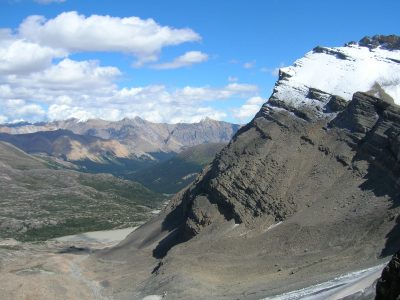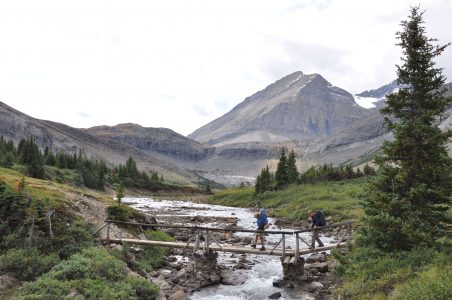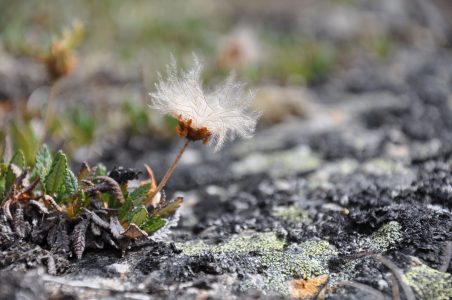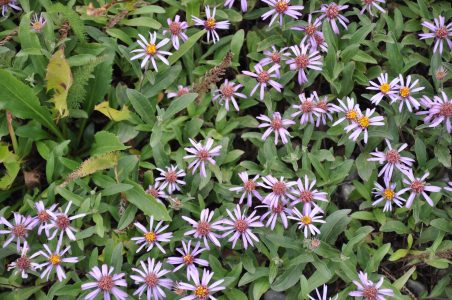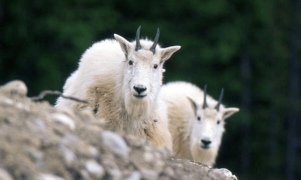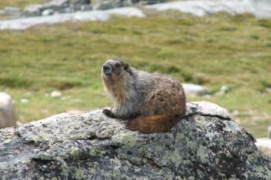

A breath-taking landscape of 10,000 foot peaks, hanging glaciers, glacial till and alpine lakes, the White Goat is a stunning piece of true wilderness.
- •
- •
- •
AWA believes the White Goat must continue to be carefully protected and managed as a Wilderness Area so that it can serve as an important benchmark for generations to come. The formal protection of adjacent lands (the Bighorn) as a Wildland Provincial Park would support the protection offered within the White Goat.
- Introduction
- Features
- Concerns
- History
- Other Areas
Tucked away along the eastern boundary of Banff National Park and the southern boundary of Jasper National Park is the White Goat Wilderness, a true piece of wilderness with 10,000 foot peaks, hanging glaciers, glacial till and alpine lakes.
White Goat’s wilderness values are protected by legislation which prohibits entry by vehicles, aircraft and horse, while its wildlife is protected by bans on hunting, fishing and trapping. It is also protected by its isolation. Access is by foot only and requires experience in wilderness travel and route finding skills.
 The White Goat Wilderness Area. Map: © AWA Files. JPG PDF
The White Goat Wilderness Area. Map: © AWA Files. JPG PDF
The White Goat is one of three Wilderness Areas, the others being Siffleur Wilderness Area and the Ghost River Wilderness. Together, they cover 1010km2 and are among the most strictly protected areas in Canada.
AWA believes the White Goat must continue to be carefully protected and managed as a Wilderness Area so that it can serve as an important benchmark of pristine Wilderness for generations to come. This would include formal protection of adjacent lands (the Bighorn) as a Wildland Provincial Park.
Status
The White Goat Wilderness Area was established in 1961, protecting 1266.11 km2 under the Forest Reserves Act, under the Public Lands Act in 1965, the Wilderness Areas Act in 1971 which was amended in 1973 under the Wilderness Areas Amendment Act. With the final revision in 1973, the park was reduced in size by 65 percent to 445 km2. This removed protection from lands further east, including Job and Coral creeks.
Management
The White Goat Wilderness Area is protected under the Wilderness Areas, Ecological Reserves, Natural Areas and Heritage Rangelands Act. The only other wilderness areas in the province are the Siffleur Wilderness Area and the Ghost River Wilderness. The Willmore Wilderness Area is protected by its own act. This very stringent form of protection reserves and protects natural heritage and provides a benchmark for pristine landscapes that have not been affected by humans. It does not permit any form of development or consumption (such as fishing or hunting) and access into Wilderness Areas is permitted by foot only.
The White Goat and Siffleur Wilderness Areas Management Plan (1992) states that the purpose of these protected areas is
“To preserve in perpetuity natural mountain landscapes while providing opportunities for present and future generations to experience wilderness”
Area
The White Goat Wilderness is 445 km2 in size, abutting both Jasper and Banff National Parks. The western boundary is a series of spectacular national parks peaks of over 3000 metres. The northern boundary is the upper Brazeau River and Jasper National Park. A rugged line of peaks that separates Coral Creek drainage from McDonald Creek constitutes the eastern boundary and the Cline River, the southern boundary.
The White Goat Wilderness Area. JPG PDF Map: © AWA
Watershed
The White Goat Wilderness Area is located within the Cline Subwatershed within the North Saskatchewan River Watershed. Major water bodies include McDonald Creek and Cataract Creek, which flow into the Cline River on the southern border of the White Goat Wilderness Area.
Geology
The White Goat Wilderness Area is in the western portion of the Cordilleran Physiographic Province within the Rocky Mountain thrust belt. It contains a small portion of the Rocky Mountain Front Ranges but remains primarily within the eastern Main Ranges (Alberta Energy and Natural Resources 1982). Most of the rocks are Lower Paleozoic carbonates with rugged and angular mountains often streaked red by dissolved iron salts. The landscape of the White Ghost was further carved by glaciers, creating valleys, tarns, and cirque lakes.
There are great ranges in elevation in the White Goat Wilderness Area, ranging from 1,464m in the Cline River Valley to 3,315 on Mt. Stewart (Alberta Energy and Natural Resources 1982).
Environmentally Significant Areas
Environmentally Significant Areas in the White Goat Wilderness JPG PDF Map: © AWA
The White Goat Wilderness is considered to be of provincial significance as it contains the range of the Brazeau Caribou Herd.
Natural Regions
The White Goat Wilderness Area is largely composed of the Alpine Subregion with some Subalpine within valley bottoms.
Natural Regions within the White Goat Wilderness JPG PDF MAP: © AWA
Vegetation
Bare rock and shale is quite extensive throughout the White Goat. Above 2100 m the climate is too severe for trees to survive, but alpine meadows contain cinquefoil, glacier lilies, buttercups, anemones, and paint brush. Vegetation also includes lodgepole pine, Engelmann spruce, whitebark pine, juniper, shrubby cinquefoil, bearberry, buffaloberry, showy aster, mountain avens, as well as extensive lichens and mosses.
Wildlife
The White Goat Wilderness Area contains part of the range of the Brazeau Caribou herd. A population estimate in 2013 placed this herd at 8 individuals (Environment Canada 2014). Other animals in the lower regions include moose, elk, deer, grizzly and black bear, cougar, gray wolf and wolverine (Alberta Recreation and Parks 1992). It is also an extensive wintering area for bighorn sheep and a major location for mountain goat outside of the national parks.
Above the treeline, golden-mantled ground squirrels, Bighorn sheep, mountain goat, pika, hoary marmot, and White-trailed Ptarmigan (Alberta Recreation and Parks 1992).
Sub-alpine birds: spruce grouse, Canada jay, waxwing, yellow warbler, pine siskin, Clarke’s nutcrackers, Rufous hummingbird, mountain bluebird, yellow-rumped warbler.
Alpine birds: ptarmigan, rosy finch, water pipit, blue grouse, horned lark (Alberta Recreation and Parks 1992).
Cultural
A survey of the Kootenay Plains suggests that the earliest nomadic people in the region were the Upper Kootenay, part of the Ktunaxa Nation, who made long and continuous use of these areas. The Kootenay people likely came in from the Columbia River through the Howse Pass, hunting bison overwintering in the Bighorn’s wide valleys.
The Rocky Mountain Nakoda’s oral history indicates they were the predominant people to have lived on the central eastern slopes of Alberta. They travelled in smaller groups in order to effectively forage and hunt in the Rocky Mountains and foothills. The nearby Big Horn Reserve is located within the region where the northern clans traditionally settled (Rocky Mountain Nakoda 2018).
As territorial boundaries were not definitive and fluctuated often, a number of other tribes also inhabited the region: the Peigan and the Blood, who joined to become part of the powerful Blackfoot Confederacy, were among these groups. The Sarcee people, now known as the Tsuu T’ina Nation near Calgary once occupied the upper North Saskatchewan River area and enjoyed a loose alliance with the Blackfoot.
Activities
Wilderness Areas permit only foot travel, and due to the distances involved, backpacking is often required. Visitors are encouraged to follow “no trace” practices in order to protect this fragile environment.
Loss of wilderness
Loss and degradation of wilderness was, and has remained, the largest threat to the White Goat Wilderness. The Bighorn Dam on the North Saskatchewan River has flooded most of the Kootenay Plains grassland that once provided important winter range for elk, deer, moose and bighorn sheep of the White Goat. Past exploration of oil, gas, and coal left its mark in the form of cut lines and access roads. Helicopter tours and fishing expeditions to nearby alpine lakes have marked impacts on fish populations, stress to ungulates, and overall detraction from a user’s wilderness experience.
Perhaps the largest risk to incremental degradation of wilderness is the increasing threat of encroaching commercial development. In general, the White Goat and the adjacent Bighorn Wildland is known and valued for being one of the last remaining areas of wilderness in the province and AWA maintains that it should remain that way. AWA believes highway-side regions are best left undeveloped. AWA is firmly opposed to any commercial development within the adjacent Bighorn Wildland as we believe it would degrade these important wilderness values.
2005
AWA writes to Alberta Sustainable Resource Development to report on observed illegal OHV activity and access signage deficiency at Whitegoat Trail. We receive a response stating they are aware of problems at the site and the activities are under investigation. ASRD state they are planning to increase patrolling in the area and replace signage.
Two individuals were prosecuted for illegal activity after needing rescue from the river and being forced to leave their vehicle in the river overnight.
1999
The draft Natural Heritage Act proposed reclassifying Wilderness Areas as Wildland Parks. Fortunately, considerable public opposition kept this strong level of protection.
1971
AWA undertakes a weekend litter cleanup trip, removing nearly a ton of garbage from the Wilderness Area.
1973
The Wilderness Areas Amendment Act is enacted in January 1973, retaining land use and recreation restrictions but deleting the size limitation of 373 km2. Unfortunately, the White Goat Wilderness Area is still reduced in size from 1266.11 km2 by 65 percent to 445 km2 as was recommended by the Advisory Committee. This removed protection from lands further east, including Job and Coral creeks (Kregosky 1975).
1971
A wilderness bill is prepared during the course of these public hearings and becomes the Wilderness Areas Act (1971). This Act re-established the White Goat under the new category of “provisional wilderness area”; however, it also subjected wilderness areas to a size review by an appointed Advisory Committee due to a 373 km2 size limitation incorporated within the Act (Kregosky 1975).
1970
Public hearings are held across the province in response to public pressure for wilderness protection.
1965
Protection of the White Goat Wilderness is re-established under the Public Lands Act by Order in Council (0.C. 1876/65).
1961
The White Goat Wilderness Area is protected by under provisions of Section 10 of the Forest Reserves Act (1950) Order in Council on January 10 1961, protecting 1266.11 km2 of wilderness (Kregosky 1975).
Pre Contact
The Siffleur Wilderness has been consistently used by Indigenous Peoples since ice retreated about 10,000 years ago.


